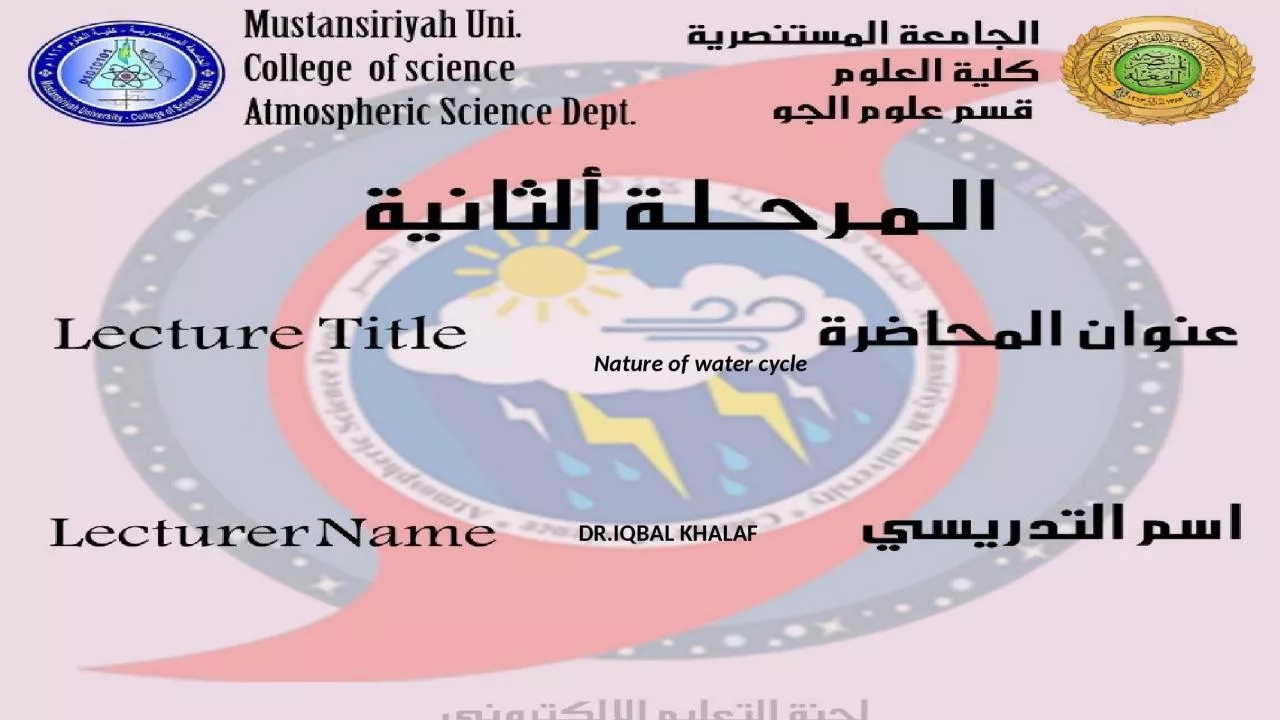

7 Evaporation It is the process of converting water from liquid to gas and is also the process of transferring water vapor from the Earth or water bodies to the atmosphere where the sun is the source of evaporation energy Evaporation often involves the erosion of plants although together they ID: 1025250
Download Presentation The PPT/PDF document "Nature of water cycle DR.IQBAL KHALAF" is the property of its rightful owner. Permission is granted to download and print the materials on this web site for personal, non-commercial use only, and to display it on your personal computer provided you do not modify the materials and that you retain all copyright notices contained in the materials. By downloading content from our website, you accept the terms of this agreement.
1. Nature of water cycleDR.IQBAL KHALAF
2. 7-EvaporationIt is the process of converting water from liquid to gas and is also the process of transferring water vapor from the Earth or water bodies to the atmosphere where the sun is the source of evaporation energy. Evaporation often involves the erosion of plants, although together they are specifically referred to as evaporation.Total annual evapotranspiration amounts to approximately 505,000 km3 (121,000 cu mi) of water, 434,000 km3 (104,000 cu mi) of which evaporates from the oceans. 86% of global evaporation occurs over the ocean.8-SublimationIs the process of converting water in solid state into vapor9-DepositionThis refers to changing of water vapor directly to ice.
3. 10-AdvectionThe movement of water — in solid, liquid, or vapor states — through the atmosphere. Without advection, water that evaporated over the oceans could not precipitate over land.11-CondensationThe transformation of water vapor to liquid water droplets in the air, creating clouds and fog12-TranspirationThe release of water vapor from plants and soil into the air. Water vapor is a gas that cannot be seen.13-PercolationWater flows vertically through the soil and rocks under the influence of gravity14-Plate tectonicsWater enters the mantle via seduction of oceanic crust. Water returns to the surface via volcanism.
4. Elements of water cycle
5. PRECIPITATIONIn meteorology, precipitation is any product of the condensation of atmospheric water vapor that falls under gravity.Precipitation occurs when a portion of the atmosphere becomes saturated with water vapor, so that the water condenses and "precipitates". Thus, fog and mist are not precipitation but suspensions, because the water vapor does not condense sufficiently to precipitate.The main forms of precipitation include all of which comes1-drizzle2- rain3- sleet4-snow5- hail
6.
7. There are two main processes that work together on precipitation:1-Saturate air2- cooling air or adding water vapor to the air.Rainfall is formed like smaller droplets by colliding with other raindrops or ice crystals within a cloud.Humidity is one of the most important factors associated with rainfall production.If enough moisture and upward movement is present, precipitation falls from the debris clouds and is in the form of precipitation from narrow rain ranges.The presence of moisture in relatively warm water bodies, which cause steaming water from lakes especially warm and which lead to snowfall from the effect of that warm lake within the cold cyclone flow around the end of tropical cyclones.The thunder enters into the head of the hurricane comma and leads to the lake's impact causing rain. In mountainous areas, heavy rainfall is possible as in this case an increase in the flow of slopes within the wind sides of the terrain at altitude.
8.
9. On the wind-facing side of the mountains, desert climates can be found due to dry air caused by pressure heating. Monsoon basin movement, or tropical convergence zone, brings rainy seasons to savannah climate.
10. Types of precipitationRainfall is important component of the water cycle and is responsible for depositing fresh water on the planet, where approximately 505,000 cubic kilometers fall each year and are divided into1-398,000 cubic kilometers of which over the oceans2- 107,000 cubic kilometers above the earth. Due to the surface area of the earth
11. Mechanisms of producing precipitation 1-convective2-strati form3-orographic rainfall.Convective processes:- involve strong vertical motions that can cause the overturning of the atmosphere in that location within an hour and cause heavy precipitation while strati form processes involve weaker upward motions and less intense precipitation.